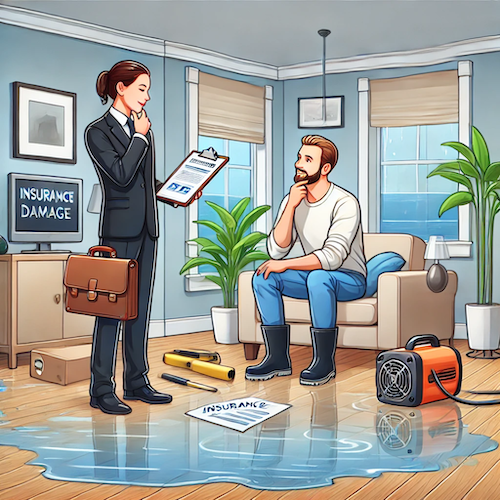Navigating Insurance Companies: A Guide for Water Damage and Mold Claims
Experiencing water damage or discovering mold in your home can be overwhelming. Between managing repairs, ensuring safety, and dealing with the emotional stress of property damage, the last thing you want is to battle insurance companies. Unfortunately, insurance claims for water damage and mold can be complex, and without the right knowledge, you may not receive the compensation you deserve.
At Elements of Restoration, we’ve worked alongside countless homeowners to help them successfully navigate insurance claims for water and mold damage. In this guide, we’ll break down the process, offer tips for maximizing your claim, and help you avoid common pitfalls.
Understanding Your Insurance Coverage
Before you file a claim, it’s crucial to understand what your homeowner’s insurance policy covers. Not all policies treat water damage and mold the same way, and exclusions can leave homeowners with unexpected expenses.
Commonly Covered Water Damage Scenarios:
- Sudden and Accidental Damage: Burst pipes, accidental overflows, and appliance malfunctions (like washing machines or dishwashers) are typically covered.
- Storm and Rainwater Damage: If heavy rains cause water to leak into your home, it may be covered—especially if the home was properly maintained.
- Fire-Related Water Damage: If water was used to extinguish a fire, most policies cover the resulting water damage.
What’s Typically NOT Covered:
- Gradual Leaks: Slow leaks over time that could have been prevented are often excluded.
- Flooding: Standard homeowner’s insurance usually doesn’t cover natural flooding—this requires a separate flood insurance policy.
- Poor Maintenance: Water damage caused by neglect or lack of routine maintenance may not be covered.
How Mold Damage is Handled:
Mold is often treated differently than water damage. Many insurance policies limit or exclude mold coverage unless it results from a covered water event (like a burst pipe). Check for policy add-ons or endorsements that can expand mold coverage if you live in an area prone to high humidity or water intrusion.
Steps to Take Immediately After Water or Mold Damage
Time is critical when dealing with water or mold damage. Taking the right steps early can protect your property and strengthen your insurance claim.
1. Stop the Source of Water (If Safe)
Shut off water lines or electricity if necessary to stop the flow and ensure safety. If flooding is from a storm or external source, wait until it’s safe to proceed.
2. Document the Damage
Take detailed photos and videos of all affected areas, including personal belongings, structural damage, and visible mold. Clear documentation is crucial for supporting your insurance claim.
3. Contact Your Insurance Company
File a claim as soon as possible. Provide your insurance company with the evidence you’ve gathered and be ready to explain how the damage occurred.
4. Call a Professional Restoration Company
Hiring a certified restoration company like Elements of Restoration not only ensures proper water removal and mold remediation but also provides expert assessments and documentation that can strengthen your insurance claim.
Tips for Navigating Insurance Claims
1. Understand Your Policy Limits
Know your coverage limits, deductibles, and any exclusions related to water and mold damage. This knowledge helps you manage expectations and negotiate effectively.
2. Keep Records of All Communication
Maintain written records of every interaction with your insurance company, including emails, phone call notes, and claim forms. Having a clear paper trail can protect you if disputes arise.
3. Be Wary of Quick Payouts
Insurance companies may offer fast settlements, but these initial offers may not fully cover your repair costs. Review all offers carefully before accepting.
4. Get Multiple Estimates
While your insurance company may recommend certain contractors, it’s wise to get multiple quotes from certified restoration experts to ensure fair pricing and quality work.
5. Consider Professional Claim Assistance
If your claim is complex or if you’re facing pushback from your insurance provider, working with a public adjuster or restoration company experienced in insurance claims can help maximize your payout.
How Elements of Restoration Supports Your Insurance Claim
We understand how overwhelming the insurance process can be—especially when you’re also dealing with property damage. That’s why we go beyond standard restoration services to assist with the insurance process.
Here’s how we help:
- Thorough Documentation: We provide detailed assessments, photos, and reports that support your insurance claim.
- Direct Communication with Insurers: We can coordinate directly with your insurance company, reducing stress and simplifying the process for you.
- Certified Restoration Services: Our IICRC-certified technicians ensure that all restoration and mold remediation work meets insurance standards.
- Advocacy for Full Coverage: We advocate for the complete restoration of your property and help you get the most out of your policy.
Let Us Help You Through the Process
Dealing with water or mold damage is stressful enough—navigating complex insurance claims shouldn’t add to the burden. At Elements of Restoration, we combine expert restoration services with insurance claim support, helping homeowners get back on their feet faster and with less hassle.
If you’re dealing with water damage, mold issues, or need help filing an insurance claim, contact us today. Our team is available 24/7 to assist with emergencies, provide expert restoration, and guide you through every step of the insurance process.
Call us now for a free consultation and let’s get your property restored—stress-free.





